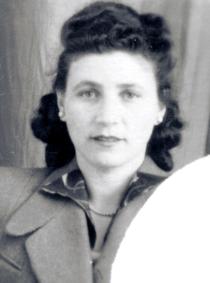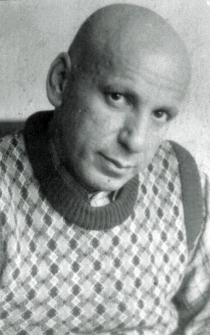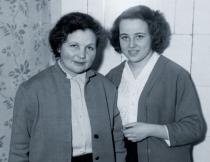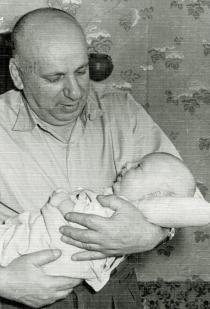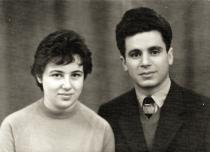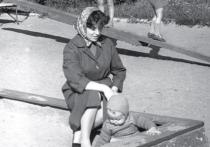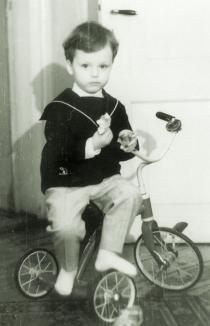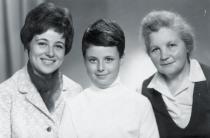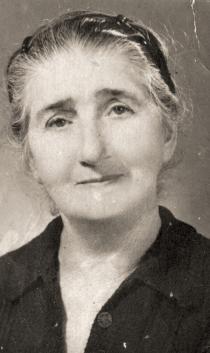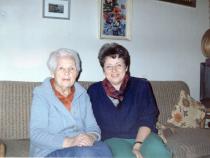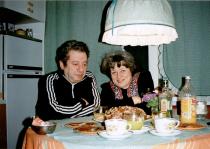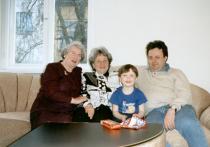This is the house owned by my father-in-law, Rachmiel Blumberg, before 1940. He had a garment store on the first floor, and the Blumberg family resided on the second floor. This photo was taken in Viljandi in 1936.
Rachmiel Blumberg was born in 1897. He came from a large and very poor Jewish family. He became a tailor's apprentice at a very young age. This was a difficult school of life. Besides his apprentice's assignments he had to do whatever housework errands. Rachmiel became a tailor. They said in Viljandi that he knew his business however young he was. He was doing well and managed to open a garment store before long. In 1934 Rachmiel married Hana, a young and talented girl. She was 17 years younger than he. In 1938 their son Moris was born, and one year later his brother Rafail came into this world. The family business prospered and everything was going well.
When the Soviet rule was established in Estonia Rachmiel already owned a large store in the center of Viljandi. It goes without saying the store was nationalized. Rachmiel's employees wrote a letter to the NKVD requesting to let Rachmiel stay as director of the store. Rachmiel came from a poor family and lived a hard life, and he knew whatever concerns were worrying common people and treated them with sympathy. His employees thought much of him. However, their letter didn't help, and Rachmiel lost his store and the job. Rachmiel took to tailoring again and had his clients.
Then 14th June 1941 came. Someone knocked on the door and Hana opened it. Those were NKVD officers. They told the family to pack promptly and leave. Rachmiel was sentenced to five years in a strict security camp in Sverdlovsk region. Hana and their two children were sent to the village of Sbornoye, in Tomsk region. Estonian and Jewish families resided in barracks. Moris was three and Rafail was one year and a half. Hana had to go to work. The term of their exile was indefinite. Rachmiel survived the camp. His craft helped him. He made clothes for prisoners and employees. Rachmiel was lucky that his expertise was in demand.
He was released in 1946 and granted permission to go back to Estonia. However, his wife and sons were sentenced to permanent residence in exile and were not allowed to relocate. Rachmiel had an entrepreneur's mind and plotted a fantastic plan. At first he planned to take his children out of Siberia, and then he thought that he might as well consider other children. It was just his luck that in 1946 there was a secret direction issued to the NKVD, according to which underage orphans were allowed to go back to Estonia. Rachmiel took care of his sons first.
When Rachmiel arrived in Estonia, he started asking, who had underage relatives in exile. Many people wanted to have their relatives back in Estonia, but this involved money to pay for the tickets, food on the way and even bribes. Very few could afford such expenses, and Rachmiel took to making leather coats. This job paid well, and Rachmiel managed to save some money. When he had the necessary amount, he traveled to Siberia to take a few children back home. He made five or six such trips. Rachmiel wanted to take back as many Estonian and Jewish children, as he could manage. This was a risky trick, but he managed all right.
There were numerous risks on the way as well: document checks, thefts and infections. Each time Rachmiel had a few children with him. Once Rachmiel was arrested, being reported to the authorities. He had to spend some time in jail. The children he had with him had to go back to Siberia. However, this mission did not stop. Rachmiel was a modest person. He never boasted or told us about this period of his life. Nobody counted how many children he managed to bring back home, but according to what he told me there must have been 35 to 50 of them.


